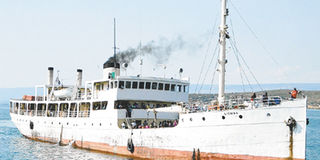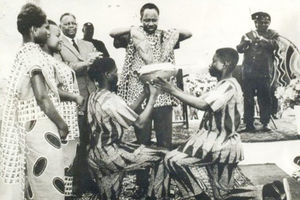MV Liemba: Sailing through history with floating museum

MV Liemba on Lake Tanganyika. PHOTO | FILE
What you need to know:
I had just recently returned from South Shields Maritime College in UK where I had completed a Radar Observer and Electronic Navigation Aids course. My bosses at Tanzania Railways Corporation (TRC) decided to transfer me from Mwanza to Kigoma to work on the MV Liemba as the second navigation officer.
Dar es Salaam. It was in January 1982 when I first saw MV Liemba at Kigoma Port. By then I was a 23-year-old young merchant navy officer, holding a second mate foreign going certificate of competency.
I had just recently returned from South Shields Maritime College in UK where I had completed a Radar Observer and Electronic Navigation Aids course. My bosses at Tanzania Railways Corporation (TRC) decided to transfer me from Mwanza to Kigoma to work on the MV Liemba as the second navigation officer.
It was at the scheduled 9am voyage in the morning when the ship was arriving at Kigoma Port from the southern-most port of Mpulungu, in Zambia. Captain Felician Nsolezi assisted by Mzee Hassan Hamisi, the veteran navigator from Ujiji, were in the bridge (the navigation deck) of the vessel giving manoeuvring commands in making fast the vessel alongside the quay.
Sailing into the harbour, MV Liemba looked magnificent with its riveted hull plates. It has a capacity of maintaining a full speed of 11 knots. She is 71.4 metres long; 9.9 metres wide; with a maximum draft of three metres and displacing a maximum deadweight of 1,575 tonnes.
From my earlier experience in Lake Victoria, where I had sailed on board various ships including MV Victoria, MV Umoja and MV Bukoba, the MV Liemba looked aged, yet quite strong and very stable.
When I received my posting letter to join the MV Liemba as a Second Mate, I did some research, hence as I was watching her coming alongside the pier, I could not but admire this ship with a great history.
The history behind MV Liemba is by intrinsic connected with that of the great lakes region and that of the great powers fight for influence in Africa.
Lake Tanganyika and MV Liemba are today also celebrated for another fact and have entered world records. MV Liemba at 101 years is recognised as being the world’s oldest passenger ship still plying todate while Lake Tanganyika, a fresh water lake, nearly one and a half kilometres deep, makes it the second deepest lake in the world, after Lake Baikal, in Russia.
Records reveal that the MV Liemba was built in 1913 at the Meyer-Weft shipyard at Papenburg in Germany and was named SS Von Goetzen after the German Governor of German East Africa, Count Gustav Adolf von Gotzen. German East Africa comprised areas which after the First World War became Tanganyika under the British; Burundi and Rwanda under the Belgians (by then called Rwanada-Urundi). The SS Von Goetzen was dismantled, packed in parts and transported to Dar es salaam where she was carried on the central railway to Kigoma.
At Kigoma she was reconstructed on a slipway and was launched on the February 5, 1915. When the First World War commenced, it was converted into a warship carrying soldiers and arms, making the Germans to have superiority in military operations in Lake Tanganyika.
After German suffered several defeats, in July 1916 they sunk the ship at Bangwe Bay, hoping to retrieve her after the war. As we know the Germans were defeated by the British who named our country Tanganyika. Unlike the other ‘spoils’ of war like the German ships “Koning”, “Moew”, “Tabora”, “President” and the “Makgraf” plying in German East Africa which were sold by the British at the prize court sitting at Zanzibar on May 20, 1920, the SS Von Goetzen salvaged by being refloated, repaired and was re-launched in 1927.
At that time, the British Imperial Government had earmarked a total of 35,000 Sterling Pounds interest free loan to the Territory Government for the construction of a new steamer capable of carrying passengers and cargo for Lake Tanganyika.
How the name was coined
However, Sir Horace Byatt the first British Governor, who named the territory Tanganyika, thought otherwise. His dispatch No. 226 dated November 8, 1923, read in part: “With reference to your telegrams of 23/10 and 26/10, I consider that when Von Goetzen has been salved and commissioned with (the vessel) Mwanza lake requirements will be met for some time to come and I am not justified in recommending another vessel.”
Thus the Governor wanted the SS Von Goetzen to be transformed into a merchant ship capable of carrying passengers and cargo.
He went further by suggesting that the money saved from the difference between repairing the ship from the allocated funds for a new ship be utilised for other use, including the improvement of the railway line between Dar es salaam and Morogoro and the Dar es salaam Port.
The colonial secretary accepted this as the cost of repairing the SS Goetzen was estimated at approximately half of the value of the new steamer.
After several delays, the repairs were finally concluded in 1925. By then the British Governor for Tanganyika was Sir Donald Cameroon. It was thus logical to have the ship registered under the British Registry, but the question was what will be her new name? From the various correspondences available at the National Archives, the government of Tanganyika Territory had not yet come up with a name.
The general manager of Tanganyika Railways in his letter dated March 9, 1925, addressed to the Governor suggested that the ship be named MV Livingstone, after the great British explorer of African hinterland. It may be said that this was a very popular name in the East and Central African region used for towns, streets and other sites worth colonial aspect.
However, under the British Merchant Shipping Act of 1894 (which was applicable by then) under Section 47 it was mandated for the name of a ship to be accepted there should be a written permission from the Board of Trade.
Thus although the Chief Secretar accepted the general manager’s suggestion, he explained in his memo dated March 31, 1925, that permission from the board must be sought.
Therefore, based on the above, on April 25, 1925, the Governor dispatched a note to Lt Col Amery, who had then replaced Sir Winston Churchill as the Secretary of State for the Colonies, informing him of the desire to register the SS Von Goetzen in the name of Livingstone.
Lyemba lya Mfipa
The reply from Lt Col Amery dated June 25, 1925, declined to register the ship in that name. In his own words he said: “I’ve the honour to acknowledge the receipt of your dispatch No. 274 of the 24th of April, regarding the renaming of the SS “Goetzen”, and to inform you that the Registrar General of Shipping and Seamen has pointed out that there are already two vessels registered in the name of “Livingstone”. Having regard to the regulations made under Section 50 of the Merchant Shipping Act, 1906, this name is not available.”
The Secretary of State went further and requested another name of the ship to be proposed.
After the name “Livingstone” failed to pass the test, the Governor told the Chief Secretary to request from all the provincial commissioners in Tanganyika to look out for a local name that the “natives” used to call Dr Livingstone to be used as the new name of the ship. Answers to this question were received from as far off as Nyasaland (Malawi) where the Chief Secretary in that territory suggested the ship to be called Mnyaka, meaning “the doctor”, the local name that the natives in that area used to call Dr Livingstone.
Another suggestion in a letter dated November 26, 1925, from the Overtown Institution in Livingstone, Nyasaland proposed the name “Monari”, while from Northern Rhodesia came “Kaguru” meaning “the man with the little dog”, a name they used to call Dr Livingstone.
Ultimately, the Governor chose the name “Liemba” which was proposed by the Provincial Commissioner for Western Province as the name of the lake that the natives used to call it when Dr Livingstone first reached those waters. To the Wafipa the lake was, and still is the “Liemba Lya Mfipa”, meaning the sea of the Wafipa.
When the name Liemba was suggested to the Secretary of State by the Governor in his dispatch dated January 8, 1926, the Secretary of State Lt Col Amery replied that instead of Liemba, the ship be named Cameroon after the Governor himself, since he had extensive career in Africa, from West Africa and then in East Africa. However, the Governor was too modest as he insisted on the name Liemba and hence the ship was registered in London as MV Liemba. This clearly shows that the “Liemba” (ship) and the “Liemba Lya Mfipa” (lake) are really destined for each other. With a name, the MV Liemba owned by Tanganyika Railways and Port Services was launched on May 16, 1927, by Mrs. Mary Katherine Scott, the wife of Sir John Scott, who was the Chief Secretary and acting governor of Tanganyika. So on that day of January 1982, as I joined the Liemba as her Second Mate, I was cognisicant of the fact that I was privileged to be part of its history.
Above me, rank wise, was the chief officer and the master of the ship. My first voyage was in the evening when the ship went to Bujumbura, in Burundi. We carried a lot of passengers and cargo on that trip.
After we returned from Burundi, we made the most interesting south- ward voyage from Kigoma to Mpulungu in Zambia. The ship sailed along the long coast of the lake passing the Mahale Mountains National Park, (the home of the Chimpanzees) through several village-ports including Kirando, Sibwesa, Karema, Kipili, Kala Kasanga until Mpulungu in Zambia. At these various village-ports the vessel anchored very close to the shore because of the depth of the water in the lake.
At Kigoma, the MV Liemba carried passengers almost to the full capacity with their portable cargos. When we reached a village port once the MV Liemba has lowered her anchor several small boats loaded with cargo and passengers came alongside.
The boats carried disembarking passengers, as the boarding ones purchased tickets from inspectors referred to as “TT” before they boarded the boats to landward.
At Mpulungu Port we mainly loaded Zambian cement destined for Bujumbura, while the Tanzanian village ports during Northwards voyage provided the much coveted sardines (“Dagaa”) destined for Kigoma port and further transported by rail or road as far as to the coastal city of Dar es salaam.
This ensured the crew of eating “ugali na dagaa” cooked in “mawese” (palm oil) as much as they pleased.
When I became the master of the MV Liemba in 1984, at the age of 26, I also made a historical achievement by becoming the youngest Captain of M.V. Liemba plying on the “Liemba Lya Mfipa”!




